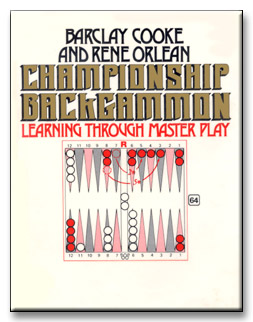|
| Book Review |
Championship Backgammon

|
Championship Backgammon, by Barclay Cooke and René Orléan, C.R. 1980, is published by Prentice-Hall of Englewood Cliffs, N.J. The list price is $19.95. |
Barclay Cooke's latest book, Championship Backgammon, provides a rare insight to the thought processes of a master player during the tense drama of a big match. Assisted by Canadian expert René Orléan, Barclay Cooke presents a fascinating play-by-play analysis of the first eight games of the 1973 championship match between Great Britain and the United States. In this extraordinary confrontation, Phillip Martyn and Joe Dwek represented the U.K., and Barclay and his late son Walter represented the U.S.
This book is written in a format that invites controversy. The potential for second-guessing is enormous when entire, real-life games are given, rather than book problems with cut-and-dried answers. While this makes the book a bit too confusing for beginners, I do wholeheartedly recommend it to players of intermediate level and higher.
Barclay's previous book, Paradoxes and Probabilities, was an excellent study in tactics. This new book branches out into overall strategies as well. The authors stress the importance of a consistent, and preferably conservative, doubling strategy. They repeatedly emphasize the conservative tactics of locking up the game before trying for the gammon, and of taking playable doubles rather than giving them. However, they are careful to note the differences between tournament and money play. A case in point is Game 3, Table 1, between Barclay and Joe. Barclay drops a double that would be a take in a money game because of the risk of being gammoned, which of course, can be far more disastrous in a tournament than in a money game or chouette.
The tactics emphasized in this book are consistent with those in Paradoxes and Probabilities. Among the tactical principles that the authors bring out most often are the importance of an anchor, the defensive value of the opponent's bar point, and the danger of splitting the back men too early. Many technical fine points are explained in the footnotes, which practically make up a backgammon mini-course of their own.
Perhaps the most important lesson in this book is that susceptibility to pressure pervades all levels of play. Great players make errors under stress just like everyone else, as shown by the four-page list of errors given at the end of the book. It is easy to look at some of the bloopers on this list and smugly state, "I would never make an error like that!" It is easy for us to say, because no one analyzes our games in depth. If anyone did, we'd probably be amazed at the atrocities we commit at even our best sessions.
Another important point is that widely varying doubling stategies can all be effective in the hands of the right players. The authors express surprise that Walt drops an early double in Game 7, and offers one that they consider premature in Game 1. Barclay himself prefers both to double and to take later, which Walt might very well have felt was too defensive. The fine tournament records of both of these professionals may go to show that there is no "correct" doubling strategy that is the same for all players. Personality evidently plays a large role in doubling decisions.
Barclay tries valiantly to avoid prejudice inn his criticisms of the players' errors, but doesn't always succeed. The book really is too hard on Martyn. While Phillip certainly makes his share of the mistakes, he gets far more than his share of the recriminations. Barclay has since stated that he regrets belaboring Phillip's errors so much. He had not intended to make Phillip look so much worse than the rest.
I recommend that as you read this book, you play out the games on your own board. Take your time, and feel free to disagree. After all, you have been invited to kibitz one of the most exciting matches in the history of backgammon.